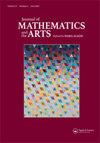Patterns in nested Platonic solids
IF 0.3
Q4 MATHEMATICS, INTERDISCIPLINARY APPLICATIONS
引用次数: 1
Abstract
In 1970 Dr. Georg Unger (1909–1999) of Dornach, Switzerland, suggested to me the Platonic solids as a topic worthy of contemplation. I was both startled and intrigued to hear a trained mathematician speak thus about such an elementary topic in mathematics. Soon thereafter I read George Adams’ Physical and Ethereal Space (Adams, 1965), with its imaginations of geometric forms created by lines and planes coming in from the infinitely distant plane, and I also came across L. Gordon Plummer’sMathematics of the Cosmic Mind (GordonPlummer, 1970); the theosophical symbolism seemed tome a bit contrived, but I found the drawings of nested Platonic solids to show some wonderful and surprising geometry. Beautiful geometric forms were swimming in my mind. I wanted to make some models to show to my students, but how could I make them physically, so they would actually hold together. Moreover, I wanted little material and clean lines that emphasize the geometric forms, so the viewer is stimulated to inwardly imagine the pure geometric forms; it is that inner activity that engages one and makes the subject meaningful. So, how to make them physically? After some trial and error, I eventually settled on metal tubes connected with bent wires and glue, with more tubes suspended inside on taut wires. When teaching projective geometry and group theory, the models captivate students’ attention and make the concepts very accessible, and in art galleries the viewers gaze with interest and wonder. Looking from different perspectives shows the viewer striking patterns. For that to work, however, precision is needed to make all of the tubes and wires line up exactly. The compound of five regular tetrahedra is very well known, models typically made in cardboard with solid faces. Figure 1 is a photo of this form cast in bronze. Figure 2 shows the same five tetrahedra, with brass tubes for edges. Figure 1 has solid faces. It adorns our home garden where the aging natural patina and the shifting daylight create varied and beautiful effects. However, due to the opaqueness of the solid faces, one cannot see a whole tetrahedron from any one perspective, and one cannot see at all the shape of the inner core. Figure 2 is actually a tensegrity figure. The 5 tetrahedra do not touch one another, but are suspended from one another with wires that form the edges of a dodecahedron on the outside. Moreover, aluminium tubes, suspended on diagonal strings, form an icosahedron嵌套柏拉图立体中的模式
1970年,瑞士多纳赫的格奥尔格·昂格尔博士(1909-1999)建议我把柏拉图立体论作为一个值得思考的话题。听到一位训练有素的数学家如此谈论数学中如此初级的话题,我既惊讶又好奇。此后不久,我读了乔治·亚当斯的《物理与空灵空间》(亚当斯,1965年),书中想象了从无限遥远的平面进来的线和平面创造的几何形式,我还读了l·戈登·普卢默的《宇宙心灵的数学》(戈登·普卢默,1970年);神智学的象征主义似乎有点做作,但我发现嵌套的柏拉图立体图展示了一些奇妙而令人惊讶的几何形状。美丽的几何图形在我的脑海里游弋。我想做一些模型给我的学生们看,但我怎么才能把它们做成实物,让它们真正地粘在一起呢?此外,我想要强调几何形状的少量材料和干净的线条,从而刺激观众内心想象纯粹的几何形状;正是这种内在的活动吸引了一个人,使主题变得有意义。那么,如何制作它们呢?经过一些尝试和错误,我最终决定用弯曲的电线和胶水连接金属管,在绷紧的电线上悬挂更多的管子。在教授射影几何和群论时,这些模型吸引了学生的注意力,使概念变得非常容易理解,在艺术画廊里,观众们带着兴趣和好奇的目光注视着。从不同的角度看,观众会看到引人注目的图案。然而,要做到这一点,就需要精确地使所有的管子和电线精确地排列起来。五个正四面体的组合是非常著名的,模型通常是用硬纸板做成的,表面是实心的。图1是用青铜铸造的这个表单的照片。图2显示了相同的五个四面体,边缘为黄铜管。图1有实心面。它装饰着我们的家庭花园,在这里,老化的自然光泽和变化的日光创造了各种美丽的效果。然而,由于固体表面的不透明性,人们无法从任何一个角度看到整个四面体,而且根本无法看到内核的形状。图2实际上是张拉整体图。这5个四面体彼此不接触,而是用金属丝相互悬挂在一起,这些金属丝在外面形成了一个十二面体的边缘。此外,悬挂在对角线上的铝管形成了一个二十面体
本文章由计算机程序翻译,如有差异,请以英文原文为准。
求助全文
约1分钟内获得全文
求助全文
来源期刊

Journal of Mathematics and the Arts
MATHEMATICS, INTERDISCIPLINARY APPLICATIONS-
CiteScore
0.50
自引率
0.00%
发文量
19
 求助内容:
求助内容: 应助结果提醒方式:
应助结果提醒方式:


